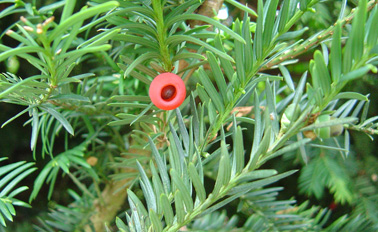|
Botanical Name:
Taxus baccata
Sthauneya consists of dried leaf of Taxus baccata Linn,
Family Taxaceae
Common Name(s) in English & Indian Languages
Sanskrit: Sukapuspa, Vikarna
Bengali: Birmi, Bhirmie, Talish Patra, Bhada Getela
English: Himalayan Yew
Guajarati: Gethela Barmi
Hindi: Thuner, Talispatra Bhed
Kannada: Sthauneyak
Malayalam: Thuriangam, Tuniyankam
Marathi: Sthauney Barmi
Oriya: Talisabhed, Chalisa Patra
Punjabi: Birmi
Tamil: Talisapatri-Bhedam
Telugu: Taleesa Patri Bhedamu
Urdu: Birmi, Zarnab
Botanical description:
A tree 40 to 50 feet high, forming with age a very stout
trunk covered with red-brown, peeling bark and topped with a
rounded or wide-spreading head of branches; leaves spirally
attached to twigs, but by twisting of the stalks brought
more or less into two opposed ranks, dark, glossy, almost
black-green above, grey, pale-green or yellowish beneath,
1/2 to 1 1/2 inches long, 1/16 to 1/12 inch wide. Flowers
unisexual, with the sexes invariably on different trees,
produced in spring from the leaf axils of the preceding
summer's twigs. Male, a globose cluster of stamens; female,
an ovule surrounded by small bracts, the so-called fruit
bright red, sometimes yellow, juicy and encloses the seed.
Parts used:
Leaves
Major chemical constituent:
Alkaloids, Glycoside, Tannins, Resins
Therapeutic uses:
• Disorders of blood (Rakta Vikara)
• Thirst (Trsna)
• Non elevated mole (Tilaka)
• Burning sensation (Daha)
• Diseases of skin (Kustha)
• worm infestation (Krmi Roga)
• Carbuncle (Pidika)
• Tumor (Arbuda / Karkata) |
|

|
|
|



